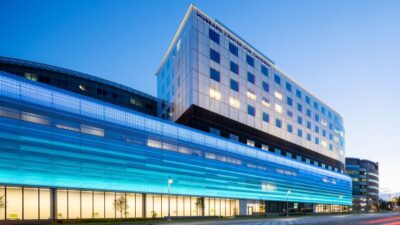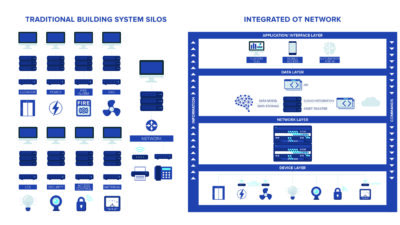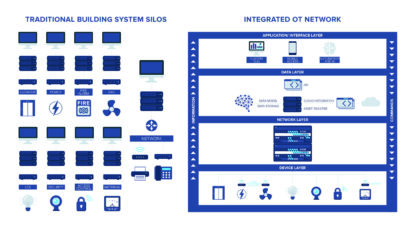As critical facilities such as data centers, telecommunications hotels and hospitals continue to occupy the workloads of engineers, so does the need for redundant power-system design. A select group of professionals, currently active with projects, discusses new technology, design challenges and strategies in the last of this year's new Consulting-Specifying Engineer feature.
As critical facilities such as data centers, telecommunications hotels and hospitals continue to occupy the workloads of engineers, so does the need for redundant power-system design. A select group of professionals, currently active with projects, discusses new technology, design challenges and strategies in the last of this year’s new Consulting-Specifying Engineer feature. Stay tuned for more compelling and informative roundtables in 2001.
CONSULTING-SPECIFYING ENGINEER : What are the biggest challenges in designing redundant power systems?
BUCCI : The first is separating the owner’s wants from needs. Most discussions start with a desire to protect a long list of loads creating the need for a system that is large, complex and costly. Refining these desires allows the designer to focus on a system that is more acceptable from a cost standpoint as well as one that is easier to operate, test and maintain.
GELFO : One of the biggest challenges I’ve faced in designing redundant or emergency power systems is ensuring that you are providing the proper amount of reliability. Too little and you’re not meeting the clients needs; too much, and you’re wasting the owner’s money. Determining the proper amount of redundancy-and balancing that need with construction costs to determine the optimum mix for the owner-is always a challenge.
KONIKOFF : A lot depends on being able to analyze the end user’s needs while keeping the project budget in sight. Often the end-user has pre-existing standards which simplify this process.
KITKO : The biggest challenge with redundant power-system design is obtaining sufficient reliability to meet the owner’s needs within a budget that allows the customer’s business plan to work.
CSE : How do you determine what type of redundancy-2N, N+1, N+2-will be sufficient for a facility’s needs?
GELFO : Every facility is unique and every owner has different expectations. Ultimately, the only way for an engineer to really determine the type and level of redundancy is by communicating with the owner. A data center will have far different needs than a hospital, which will have different needs than an office building, and so on. Even within a facility, various areas might require different levels of redundancy. Uninterruptible power-supply (UPS) systems may be required in one area for uninterruptible power solutions, a generator may be needed in another area for long power outages and battery backup in lighting fixtures may be all that is necessary in yet another area.
BUCCI : We start with an analysis of the risks. We look at the things that could cause a loss of power, the likelihood of those things happening and the results for our client’s operation. We discuss the level of protection that the client sees as appropriate and usually discuss a couple of options that can be priced. The final decision is usually made based on price as well as risk.
KITKO : The owner must carefully select a consultant with experience in similar facilities. The consultant can perform probability studies to determine the system reliability if the owner knows how much reliability is required. If the owner does not know this, the staff of decision-makers needs to meet with the consultant to come to an understanding about system approach and redundancy and cost issues, which includes the cost of the system equipment as well as the revenue lost by the owner when an outage occurs. Only then can the owner make the correct decision in determining the redundancy required.
Redundancy is a risk assessment. It is similar to an insurance policy; the less risk the owner wants to take, the higher the cost.
KONIKOFF : Again, end-user standards often dictate system architecture. Also, the size of facility and the type of equipment proposed can drive the decision.
For example, a tech room equipped with servers having dual power supplies lends itself to a 2N UPS system with stand-alone static switches. Each static switch feeds a distribution board and two independent sets of power-distribution units [PDUs]. Each server cabinet gets fit out with two plug strips, each fed from a separate PDU and UPS. If one UPS fails, the static switch flips over and the UPS that remains on-line serves both PDU groups.
Scheming for good design
CSE : What are some design schemes that you’ve seen successfully employed for specific kinds of facilities?
KITKO : Banks, brokerage facilities, some co-location facilities and mission-critical facilities are usually at 2N or N+2. Carrier facilities, co-location facilities, data centers and call centers are usually at N+1.
BUCCI : The scheme we employ most often includes a generator feeding a UPS that then feeds several PDUs. The PDUs are either fully redundant or don’t depend on the assessed risk. The UPS equipment is always redundant and usually has a maintenance bypass as well.
KONIKOFF : Where continued operation during a blackout is required, one or more generators can be added, depending on the level of protection required. Where more than one generator is to be installed, we tend to favor isolated redundant systems with tie breakers because of their simplicity.
GELFO : Most of the facilities I deal with are healthcare facilities. In most hospitals, redundancy and reliability are the key concerns, so typically for large loads-one megawatt and above-we recommend multiple generator sets operated in parallel to serve hospital essential-system loads via automatic transfer switches with bypass isolation. We also typically recommend two utility services, preferably from separate substations, either switched by the utility as preferred and alternate feeds, or serving two ends of a double-ended switchboard connected by a tie-breaker. Providing redundancy in utility services helps ensure minimal outage intervals to the hospital.
We’ve also designed numerous data centers, which generally require more redundancy with absolutely no interruption. This is typically accomplished via generator sets in combination with UPS systems and static transfer switches.
CSE : What types of systems, equipment and products are typically employed?
KONIKOFF : Engine gensets, UPS units, static switches, wrap-around maintenance and by-pass.
GELFO : Typical products we specify are diesel-engine generator sets, paralleling switchgear, automatic transfer switches and UPS systems-both centralized and local systems. We almost always recommend that transfer switches be specified with a maintenance – bypass isolation feature. This allows the transfer switching mechanism to be bypassed, so the switch can be maintained or repaired without loss of power to the loads served by the switch.
We also recommend and specify additional battery backup for critical low-voltage systems to provide an added measure of redundancy and reliability.
KITKO : Electrical distribution systems utilizing generators, UPS, PDUs, static switches and switchgear are typically employed.
BUCCI : We most often see a diesel generator that provides backup power to a redundant UPS. The UPS is a solid-state version designed with redundant modules.
CSE : How does power quality come into play when designing these systems?
GELFO : Power quality has become more critical over the last several years with the increasing use of computer and electronic equipment. Power quality delivered by utility companies seems to be getting worse, so more attention is necessary to ensure quality power within a facility than ever before. The power systems designed ultimately must take power quality into account. Most of this new electronic equipment is sensitive to power surges, spikes, harmonics and line interference. Surge suppressors, power conditioners, UPS systems , harmonic filtering and distribution-system design/segregation can all be used to help limit these problems.
BUCCI : We’ve been treating power quality as a separate issue. We use equipment that is specifically designed for improving power quality where it is needed and don’t try to accomplish both with the back up equipment.
One reason is that we want to address power quality independent of the source of the power and we also want to address it for loads that are not supplied with backup power.
KITKO : Power quality is always a critical element. Facilities like banks, data centers and carrier facilities cannot have downtime, so a UPS is incorporated to allow the generators time to come on-line without an outage. This system provides for clean power in most cases.
Give it some space
CSE : Are space requirements sometimes difficult to deal with?
GELFO : Yes. Typically, usable floor space is at a premium, so architects and owners are reluctant to give up space for non-revenue-producing areas like electrical rooms and generator rooms.
But in order to provide systems that are flexible enough to change with ever-changing power requirements, not only is space needed for the redundant and emergency-power systems, but space should also be provided for future expansion of these systems. Sometimes it can be difficult to justify “empty space” for future equipment to an owner.
KONIKOFF : Absolutely. The key is getting all players to set aside sufficient space for UPS, batteries, PDUs, AC units-often also N+1-circulation space and space for the cabinets.
BUCCI : We’ve not had a problem getting space for this equipment. The need is so great and such an integral part of the project scope that this need is readily addressed.
KITKO : Space requirements increase in multiples as the reliability is increased. It is always important to include the cost to construct space in the reliability analysis. Space needs to be identified early in the design process, whether one is selecting a green-field site or incorporating into an existing site by using existing space or providing an addition.
CSE : What are some ways to keep the costs down with these projects?
KITKO : Identifying the correct electrical loads and future requirements, and then selecting the correct reliability will minimize the costs of these types of projects.
BUCCI : The biggest cost-saving option is to refine the list of loads so your system is sized to address needs only. The second option is to look at levels of critical loads and to provide different levels of redundancy for different loads.
KONIKOFF : Don’t build more capacity and redundancy than the user really needs. It gets back to the need to start with an adequate assessment of what the user really requires.
GELFO : Cost is always a concern to facility owners and therefore to us as engineers acting on the owner’s behalf. The issue is not how low you can keep the cost, but how to maximize the benefits of a cost-effective design. Maintaining open specifications to ensure competitive pricing, limiting the level of redundancy to only what is needed and allowing for future expansion are ways to be sensitive to these cost issues.
We typically try to design space for the addition of future generators or UPS systems, especially when the owners want more redundancy than they can afford. Ultimately, however, there is more of a cost associated with redundancy.
CSE : What type of utility-grid interconnection issues arise when designing redundant power systems?
GELFO : Many utility companies are interested in co-utilization of redundant power systems installed in large facilities. We see this a great deal in hospital design, because most hospitals have load profiles that are attractive to utility companies. There are many opportunities when dealing with power companies ranging from simply taking load off of the utility grid by running the facility’s generators to exporting or selling power produced by a facility’s generators back to the utility company.
When interconnecting with the utility grid, the method of paralleling the generators with the grid is the most critical design aspect. However, by selecting the appropriate equipment for metering, control systems and interface protection, the results can be highly beneficial to everyone involved.
KITKO : First and foremost is to verify the time frame in which the utility can provide power to the site. In many cases, the utility will provide a percentage of the power in the initial start-up, with the remaining requirements provided at a later date. Close communication must be maintained with the utility throughout the design process to establish how and where the interface is best established.
The cost of the utility connection must also be established early on. These costs can be substantial and may have an impact on the project budget. It is important to understand the utility-grid reliability.
KONIKOFF : The real issue is power capacity. Each utility has its standard means of providing service, and that will not change. The key is working with them and arranging to purchase “excess capacity” when required.
BUCCI : We generally look for either a utility network-with its inherent reliability-or for two separate utility feeds and automatic switching between them.
CSE : Has deregulation had any noted effects on your redundant power system designs?
KITKO : Not much to date. It seems that in the long run, cogeneration will take on a larger role. It seems that many of the companies that will be owning and operating the cogeneration facilities are taking a wait-and-see attitude. A byproduct of the cogeneration facility will be steam, which can provide air conditioning to the data facility.
GELFO : Even here in Florida, where deregulation has not begun yet, we are seeing some peripheral effects as utility companies prepare for deregulation. The utility companies seem more open to partnering with the facilities they serve, trying to develop long-term agreements with large power users. For a new hospital in the Florida Keys, the utility company was willing to partner with the hospital by purchasing the hospital’s generators and paralleling equipment in exchange for taking the hospital’s load off of the grid and backfeeding excess power to the utility grid with the generators during the utility’s peak load times.
We are also starting to see utility companies willing to build and maintain central energy plants for larger facilities and lease services-power, emergency power, chilled water-back to the facility. Obviously, this type of partnership must be carefully coordinated to maintain the redundant power system needed for the facility.
Raising the bar
CSE : What types of technological advancements would improve the efficiency and quality of redundant power systems?
BUCCI : I think that more intelligent circuit breakers will allow us to design protection schemes that can select from among available power options and automatically acknowledge that the selected source will meet the load needs.
GELFO : Like most technology, advancements in making generator sets and UPS systems smaller, cheaper, faster and more efficient will ultimately benefit owners and end-users by making redundant power systems more accessible and more effective.
Also, integrating newer technologies such as fuel cells into the design of redundant power systems will be an interesting challenge.
KITKO : I think that in the next 10 years we will see fuel cells being utilized. As the cost of oil increases and fuel-cell technology improves, these alternative sources will become more cost effective. In my opinion, the biggest advantage of fuel cell use will be a cleaner atmosphere.
CSE : What skills and experience does an electrical engineer require to successfully execute such project designs?
GELFO : As always, an engineer with a vast amount of experience in designing and building redundant power systems is the best qualified to ensure a successful project. The ability to communicate with the end-user to determine and understand what the exact needs and wants are is an absolute must to be able to determine the most reliable, cost-effective system for the facility. Coordination and fault studies are also a critical part of ensuring a reliable redundant power system.
Experience is needed not just in designing and selecting equipment, but also in supervising the installation, testing and continuously following up with the facility to see how the system is operating and meeting the owner’s needs. This level of service we have found to be absolutely necessary to ensure a successful project.
BUCCI : The most important thing is to be able to understand the clients needs and to offer suggestions-at various cost levels-that will meet those needs.
KITKO : Electrical engineers require a full understanding of electrical-system short circuit and coordination, electrical grounding, system reliability, communication skills and electrical distribution equipment.



